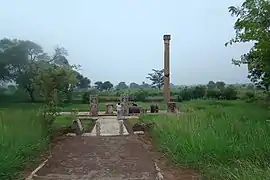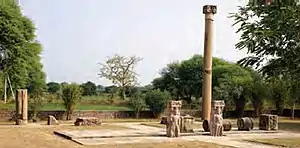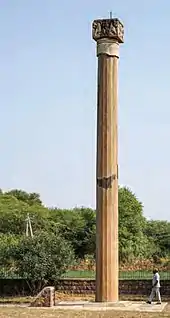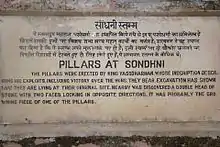Sondani | |
 Victory pillar of Yashodharman at Sondani, Mandsaur | |
 Shown within India  Sondani (Madhya Pradesh) | |
| Coordinates | 24°02′29″N 75°05′30″E / 24.0413°N 75.0918°E |
|---|---|
| Type | Monuments |
Sondani (सोंधनी), also Sondhni, is a small village at a distance of about 4 km from Mandsaur situated on Mahu-Nimach Highway towards Mahu.
Victory monuments (525 CE)
The spot is famous for a series of monuments with inscriptions, established by Yasodharman (ruled 515 – 545 CE), who praised himself for having defeated the Alchon Hun king Mihirakula.[1]
Mandasor stone pillar inscription of Yashodharman."He (Yasodharman) to whose two feet respect was paid, with complimentary presents of the flowers from the lock of hair on the top of (his) head, by even that (famous) king Mihirakula, whose forehead was pained through being bent low down by the strength of (his) arm in (the act of compelling) obeisance"
The victory monuments consist in two pillars, with various other sculptural elements pointing to the existence of a former temple at this spot.[3]
Style
The art and style of the sculptural remains at Sodani are considered as a good marker of the final period of Gupta art, being dated to the reign of Yasodharman (ruled 515 – 545 CE), and more precisely to about 525 CE.[4][5] After that point and for the next centuries, Indian politics became extremely fragmented, with the territory being divided between smaller dynasties.[6] The art of Sondani is considered as transitional between Gupta art and the art of Medieval India: it represents "an aesthetic which hovered between the classical decorum of Gupta art on the one hand and on the other the medieval canons which subordinated the figure to the larger religious purpose".[7]
 The Sondani site in 1908
The Sondani site in 1908 Plan of Sondani
Plan of Sondani Sondani overview
Sondani overview Sondani pillar
Sondani pillar Sondani, two Dvarapalas
Sondani, two Dvarapalas Vidyadhara, Sondani, circa 525 CE. National Museum, New Delhi
Vidyadhara, Sondani, circa 525 CE. National Museum, New Delhi Sondani pillar capital
Sondani pillar capital Info of Victory pillar of Yashodharman at Sondani, Mandsaur
Info of Victory pillar of Yashodharman at Sondani, Mandsaur Sondani reliefs
Sondani reliefs
References
- ↑ Coin Cabinet of the Kunsthistorisches Museum Vienna
- ↑ Punjab Monitor, April 2013 , from Fleet, John F. Corpus Inscriptionum Indicarum: Inscriptions of the Early Guptas. Vol. III. Calcutta: Government of India, Central Publications Branch, 1888, 147-148.
- ↑ Bakker, Hans (2017). Monuments of Hope, Gloom, and Glory in the Age of the Hunnic Wars. 50 years that changed India (PDF). Amsterdam: J. Gonda Fund Foundation of the KNAW. pp. 484–534. ISBN 978-9069847153.
- ↑ Coin Cabinet of the Kunsthistorisches Museum Vienna
- ↑ Williams, Joanna (1972). "The Sculpture of Mandasor" (PDF). Archives of Asian Art. 26: 63. ISSN 0066-6637. JSTOR 20111042.
- ↑ "The reign of Yasodharman thus forms an important dividing point between the period of the imperial Guptas, whom he emulated, and the following centuries, when India fell into a kaleidoscopic confusion of shifting smaller dynasties" in Williams, Joanna (1972). "The Sculpture of Mandasor" (PDF). Archives of Asian Art. 26: 52. ISSN 0066-6637. JSTOR 20111042.
- ↑ Williams, Joanna (1972). "The Sculpture of Mandasor" (PDF). Archives of Asian Art. 26: 64. ISSN 0066-6637. JSTOR 20111042.
